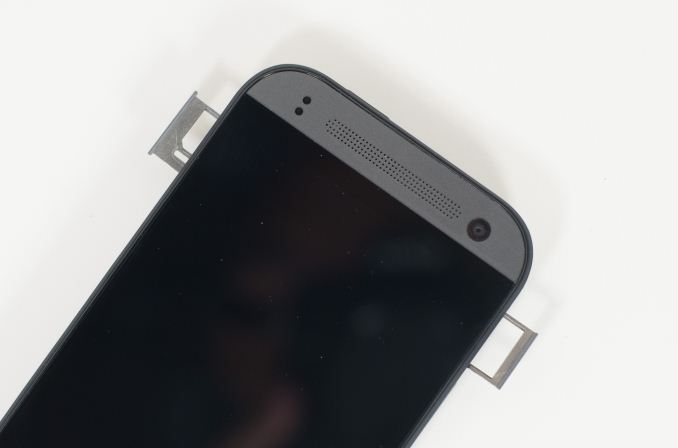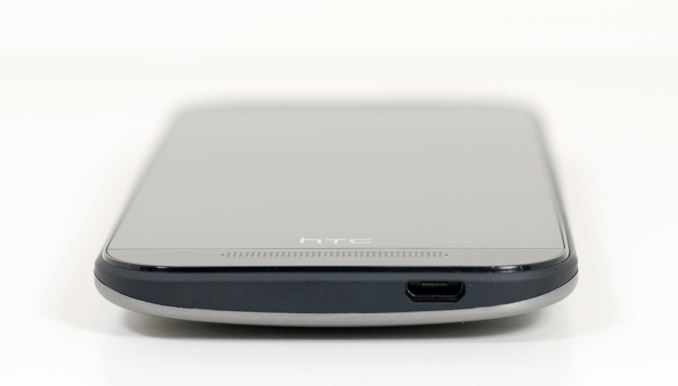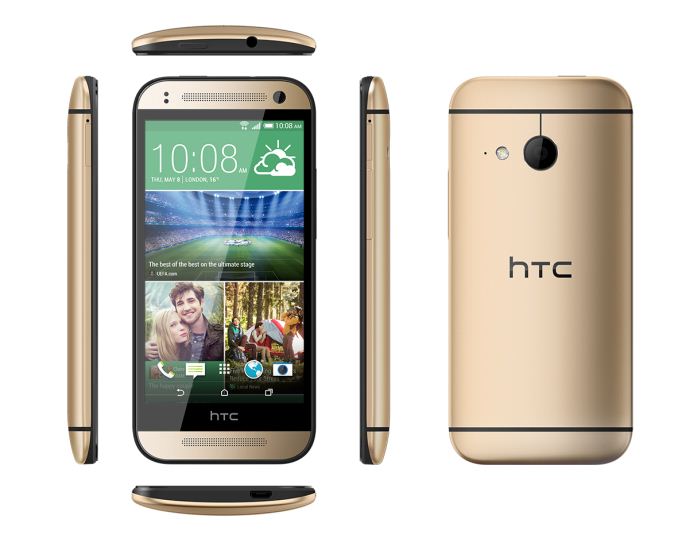HTC One mini 2 Announcement
by Anand Lal Shimpi & Joshua Ho on May 15, 2014 3:00 AM EST- Posted in
- Smartphones
- HTC
- Mobile
- One mini 2

Today, HTC is launching the HTC One mini 2, a phone that is supposed to be a smaller version of the HTC One (M8), both in price and size. As a direct successor to the HTC One mini, a surprising amount has changed. The camera is no longer the Ultrapixel sensor, the display and overall size increase, NFC shows up, and the SoC has been changed to use a quad core Cortex A7 setup over the dual core Krait setup from last year. A list of the differences between the One mini, One mini 2, and One (M8) can be seen below.
| HTC One mini 2 | HTC One (M8) | HTC One mini | |
| SoC | MSM8926 1.2 GHz Snapdragon 400 | MSM8974ABv3 2.3 GHz Snapdragon 801 | MSM8930 1.4 GHz Snapdragon 400 |
| RAM/NAND | 1 GB, 16GB NAND + microSD | 2GB LPDDR3, 16/32GB NAND + microSD | 1 GB LPDDR2, 16GB NAND |
| Display | 4.5” 720p LCD | 5” 1080p LCD | 4.3" 720p LCD |
| Network | 2G / 3G / 4G LTE (Qualcomm MDM9x25 UE Category 4 LTE) | 2G / 3G / 4G LTE (Qualcomm MDM9x25 UE Category 4 LTE) | 2G / 3G / 4G LTE (Qualcomm MDM9x15 UE Category 3 LTE) |
| Dimensions | 137.43 x 65.04 x 10.6mm, 137 grams | 146.36 x 70.6 x 9.35mm max, 160 grams | 132 x 63.2 x 9.25 mm, 122 grams |
| Camera | 13MP rear camera, 1.12 µm pixels, 1/3.06" CMOS size, F/2.2. 5MP f/2.8 FFC | 4.0 MP (2688 × 1520) Rear Facing with 2.0 µm pixels, 1/3" CMOS size, F/2.0, 28mm (35mm effective) and rear depth camera, 5MP f/2.0 FFC |
4.0 MP (2688 × 1520) Rear Facing with 2.0 µm pixels, 1/3" CMOS size, F/2.0, 28mm (35mm effective) no OIS 1.6 MP front facing |
| Battery | 2100 mAh (7.98 Whr) | 2600 mAh (9.88 Whr) | 1800 mAh (6.84 Whr) |
| OS | Android 4.4.2 with Sense 6 | Android 4.4.2 with Sense 6 | Android 4.4.2 with Sense 5.5 |
| Connectivity | 802.11a/b/g/n + BT 4.0, USB2.0, GPS/GNSS, MHL, DLNA, NFC | 802.11a/b/g/n/ac + BT 4.0, USB2.0, GPS/GNSS, MHL, DLNA, NFC | 802.11a/b/g/n + BT 4.0, USB2.0, GPS/GNSS, MHL, DLNA |
| SIM Size | NanoSIM | NanoSIM | MicroSIM |
As seen above, the One mini 2 is a noticeable step up from the One mini. The battery is larger, the modem supports LTE category 4 and carrier aggregation if two WTR1625Ls are on the device (though it doesn't appear that the One mini 2 has such a setup based upon the information that we've seen). The front facing camera appears to be the same as the one in the One (M8), and the design is largely similar as well. On the audio side, HTC has stated that the One mini 2 uses the same amplifiers on the speakers and 3.5mm jack as the One (M8). However, the second 2MP sensor is gone from this version, as is the dual temperature LED flash.
The most shocking change is likely to be the main rear camera sensor, which forgoes the 4MP UltraPixel sensor for a traditional 13MP camera with 1.12 micron pixels. HTC is quick to point out that not only is the 13MP camera cheaper than the two sensor DuoCam solution on the M8, but it's also cheaper than the single 4MP UltraPixel sensor. HTC remains committed to its UltraPixel strategy, but on the One mini 2 cost has a much higher priority than low light performance.
The One mini 2 also loses Zoe, Panorama 360, and dual capture, only leaving the standard still, video modes with scene selection capability. It seems pretty clear that the ISP on the MSM8926 just isn't powerful enough to support dual encode capabilities, and it's likely that Pan 360 required too much compute to be realistically usable on the One mini 2. This seems to also be reinforced by the dramatically longer shot to shot latency on the One mini 2, which can be slow enough to display a "Saving..." toast if the gallery icon is tapped immediately after taking a photo. While the preview of the One mini 2 is noticeably lower in quality and resolution than the One (M8), in good lighting conditions it's clear that it has better detail, although it will take more extensive tests to truly determine how the cameras stack up.
On the SoC front we have to deal with the confusion that stems from Qualcomm's overly simplified branding. Although both minis use a Snapdragon 400 SoC, the original mini featured an MSM8930 (2 x 1.4GHz Krait 200 cores) while the updated mini moves to a quad-core 1.2GHz Cortex A7 design (MSM8926). CPU performance should improve a bit with the move to Cortex A7. The GPU is still Adreno 305.
Outside of simple specs, the hardware is very different from the One (M8). The design, once a wrap-around body of aluminum, now ends around the volume rocker, leading to an M7-esque plastic sidewall that is grippy and makes for a neat design flair. The mini 2 eschews the M8's aluminum unibody for three pieces of aluminum laid into the plastic midframe. Ignoring the display, 90% of the M8's body was made of aluminum. By the same metric only 50% of the mini 2's body is aluminum. Even the One mini 2's conservative use of aluminum is substantial compared to other phones with similar specs.
Note that although the volume rocker on our gunmetal gray sample is silver, that will only apply to the first batch of units to hit store shelves. Subsequent batches of gunmetal One mini 2s will have a gunmetal volume rocker that matches the rest of the device. Just like the M8, the One mini 2 will be available in silver and gold as well.
The dual stereo speakers are still present, and HTC has moved the proximity/light sensor to the left side of the phone, and pushed the front facing camera to the right to equalize the width of the two speaker grilles. The display grows in size compared to the original mini (4.5" vs 4.3"), although it's still a 720p LCD panel. The larger display drove a larger chassis, which also enabled the use of a slightly larger battery (7.98Wh vs 6.84Wh). With very low power hardware under the hood, the One mini 2 should be pretty decent when it comes to battery life.
This phone looks and feels very much like a merger of the One 2013/M7 and the M8, even in size. The top-mounted 3.5mm jack, power button on the top-left, and single LED flash to the left of the camera are all reminiscent of the M7. While the One mini 2 is still significantly smaller than the One (M7), it is much closer than one would expect, and their sizes are almost equivalent. If the One mini was "just right" for you, the One mini 2 is likely to be at the edge of comfort or slightly too large. For most people, I suspect that this will be of a much more comfortable size than the One (M8), although the display placement still feels too tall due to the on screen buttons, which shift the keyboard further up than one might expect.
 The addition of a microSD slot and nano SIM support are borrowed from the M8
The addition of a microSD slot and nano SIM support are borrowed from the M8
The One mini 2 is definitely an upgrade from the original. Just like with the One mini, expectations have to be adjusted to fit the lower price bracket that this phone will slot in. The One mini 2 isn't just a smaller version of the M8, but like its predecessor it is also a lower specced device.
Unlike its predecessor however, the One mini 2 launches in a world where the Moto G LTE will soon exist. With similar hardware underpinnings but priced at $219 compared to the One mini 2's $360+ expected price point, HTC is betting on its material choice and design to move units. It's a conscious bet that look and feel matter more than specs at this price point. There's definitely room for HTC to price the One mini 2 above the Moto G LTE, but it's difficult to judge just how much higher HTC can go.
The One mini 2 will be available in Europe and Asia beginning in June. There's no US launch planned at this point.



















56 Comments
View All Comments
londedoganet - Thursday, May 15, 2014 - link
Not quite surprised that the HTC One mini 2 is not actually a downsized HTC M8 (because the original One mini wasn't a downsized HTC M7 either), but why can't more companies follow Sony's lead and at least try to deliver a no-compromises small-screened flagship a la the Xperia Z1 and Z1 Compact?lkb - Thursday, May 15, 2014 - link
I think samsung is being too successful in pushing the Smartphone industry screen size, to see a real change in this trend. I am on a 4.7 inch nexus 4 and while I am waiting anxiously for the 6th iteration of the Nexus line, I am afraid its going to be a 5.x inch monster.Impulses - Thursday, May 15, 2014 - link
There might not be any more straight up Nexus devices if the Android Silver rumors hold true... Although those kinda rumors have been around for a while. It's unclear how Silver/Play Edition/Nexus is gonna congeal in the next gen.Death666Angel - Thursday, May 15, 2014 - link
Rumors I heard were that Silver was starting next year and that this year we would get a normal new Nexus phone. :)Azurael - Thursday, May 15, 2014 - link
Yeah, I'd probably be up for a smaller phone with a high-end SoC and decent camera. I felt like the Nexus 4 and One X I had previously were the largest I'd really like a phone to be. I've currently got a G2 because the Screen on the Nexus 5 looks dreadful to me (can we have some contrast, please?) but it really is too big. I guess I can live with that for the outstanding battery life but I really wish the phone was 3/4 the size...Flunk - Thursday, May 15, 2014 - link
Yeah, that LG display on the LG Nexus 5 is really terrible compared to the LG screen on the LG G2.Azurael - Friday, May 16, 2014 - link
I can't tell if this is sarcasm, if it is: the display on the Nexus 5 is terrible compared to the G2. In actual fact, the panel in the N5 is made by JDI, not LG but I suspect it's more to do with cutting costs than who made it. Some G2s also have JDI made displays, although if they look significantly different to the LG display in my G2, I've never seen one. The N5 might have a colour calibration that's closer to reality out of the box but it visibly lacks contrast even compared to the Nexus 4 I had before. Although it's not quite a fair comparison because the N4 benefited a lot from using a different calibration to the way Google shipped it...Impulses - Thursday, May 15, 2014 - link
I thought Moto at least landed at a better set of compromises with the Moto X... I'd probably be rocking one if it had been cheaper from the start and had better band support. Went Nexus 5 in the end for the combination of price/specs and Spark support.goldsilver00 - Thursday, May 15, 2014 - link
I totally agree, why is this tendency to make smartphone even bigger, even when they are supposed to make a smaller version, it is still bigger that the iphone 5. Apple is going to create so new 5 inch screen's phone, so I guess there is a market for that. Not me however, I have big hands thoughkevith - Thursday, May 15, 2014 - link
I´l second that.Smaller size and bigger muscles, please.